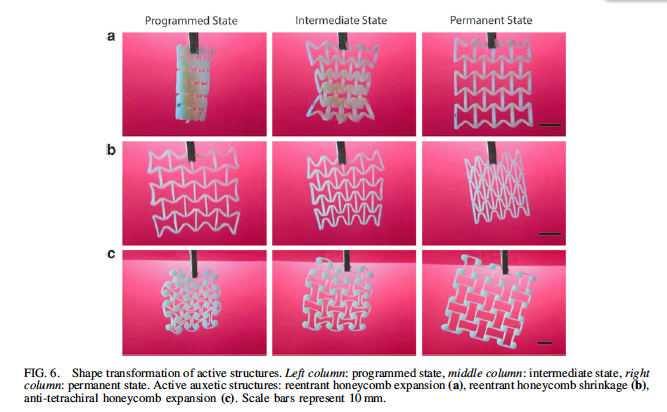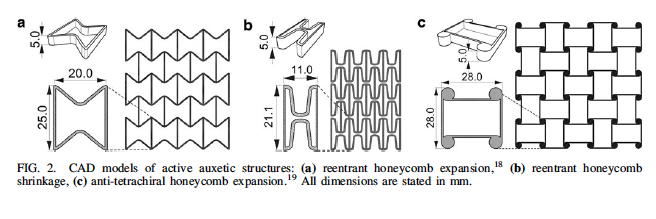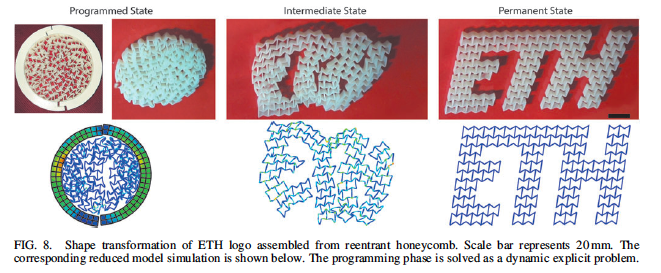As part of research into the development of four-dimensional (4D) printing and active self-deploying structures, scientists from ETH Zurich have proposed a series of 3D printed auxetic meta-materials. The materials may be used in biomedical devices, engineering structures, and aerospace applications.
Such materials, capable of achieving area changes of up to 200%, are are 3D printed geometrically complex active structures with shape memory. They can be programmed into versatile shapes before regaining their original shape through an external stimulus.
The fourth dimension
In the recently recently published paper, authors Marius Wagner, Kristina Shea, and Tian Chen from ETH Zurich’s Institute for Material Design and Fabrication (and also behind research on self-deploying 3D printed trusses) define 4D printing as 3D printing with the added dimension of change over time.
In this study, the ETH scientists used Shape Memory Polymer (SMP)-based shape transforming auxetic meta-materials that can be tiled to form active structures.
The use of SMPs aims to address the limitations of imprecision from manual programming of materials, and the limited achievable shape change for multi-material 3D printed Printed Active Composites (PACs), all of which were faced by other published 4D printed structures.
According to the authors of the paper, “the versatility of the proposed meta-materials enables the tiled structures to be programmed into multiple shapes,” and the structures printed from the meta-materials allows tiled structures to be “programmed into multiple shapes” with “both their permanent and programmed states precisely defined.”

Preparing and printing the structures
The thermo-mechanical properties of the 3D printed polymer were initially characterised, before a “linear viscoelastic” constitutive model was constructed using this experiemental data. This model was used to simulate a model. This model was then subjected to a three point bending test.
The 3D printed meta-materials were then 3D printed from a single material using inkjet processes, simplifying their fabrication. A Stratasys Objet350 was used to 3D print the complex structures by UV curing VeroWhitePlus RGD835 (VW+) material.
Testing the material for wider use was then carried out by recording the glass transition temperature (Tg) , the fully relaxed modulus, the coefficient of thermal expansion (TE), and, frequency sweeps of the storage modulus at different temperatures.

Design and testing of active structures
The active auxetic meta-materials were 3D printed into a number of formations for testing. The first shape was a compressible re-entrant honeycomb which geometrically allowed changes in area of up to 160%.
The second, a reentrant honeycomb structure was capable of shrinking by around 200% in area. The third and final formation was a anti-tetrachiral honeycomb structure which could contract and recover with an increase in area of 50%.
During the testing stage, the structures were pre-programmed into the ETH logo. When subjected to a heat stimulus, the structures then recovered their permanent logo formation.
The permanent shape of all of structures was recovered in less than 10s at 80 degrees celsuis. However, the re-entrant honeycomb structure saw the greatest size change of 200%.

A possibility for self-adapting structures
Applications for 4D printing are especially important the material cannot be reconfigured manually or where electromechanical actuation is not feasible (such as in space or inside the human body). These designs can be programmed into versatile shapes and recover their original state when subjected to temperatures above the SMP.
The paper’s authors state that the technology “will be exploited in future studies to design structures that are capable of adapting their mechanical properties to their environment in a controlled manner.”
The full paper, entitled “Large Shape Transforming 4D Auxetic Structures” by Wagner Marius, Chen Tian, and Shea Kristina is available to read here.
For more information on 3D printing research, subscribe to our free 3D Printing Industry newsletter, follow us on Twitter, and like us on Facebook.
Featured image shows reentrant honeycomb structures transforming their shape. Photo by Jung-Chew Tse.


